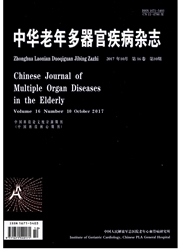

 中文摘要:
中文摘要:
目的 初步探讨帕金森病(PD)伴发不宁腿综合征(RLS)患者的运动症状和非运动症状(NMS)的关系。方法 对连续就诊于北京天坛医院神经内科和老年病科的165例PD患者采用不宁腿综合征评定量表(RLS-RS)评价RLS的临床表现及严重程度,分为RLS组和非RLS(NRLS)组,并完成运动症状及NMS量表的测评。结果 (1)165例PD患者RLS的发生率为42.4%;RLS组的病程明显长于NRLS组(P<0.05)。(2)RLS组Hoehn-Yahr分期及UPDRS Ⅲ评分均明显高于NRLS组(P<0.05)。(3)RLS组剂末现象与异动症的发生率明显高于NRLS组(P<0.05);两组开关现象的发生率无明显差异(P>0.05)。(4)RLS组NMS发生的平均例数多于NRLS组(P<0.05);RLS组近记忆力减退、抑郁、焦虑、注意力下降、淡漠及性功能障碍等NMS的发生率明显高于NRLS组(P<0.05)。(5)RLS组与NRLS组NMS的相关量表测评结果比较,UPDRS Ⅰ,HAMD,HAMA,PSQI,FS-14,FSS和SCOPA-AUT症状的种类和SCOPA-AUT症状的例数比较,差异具有统计学意义(P<0.05)。两组MoCA,MAES和ESS评分比较,差异均无统计学意义(P>0.05)。(6)RLS组与NRLS组的UPDRS Ⅱ及PDQL评分比较,差异均具有统计学意义(P<0.05)。结论 RLS是PD常见的NMS之一,与运动障碍及运动并发症有关;PD伴发RLS患者的NMS发生率更高,精神、情感、自主神经功能及睡眠障碍更突出,日常生活能力及生活质量更差。
 英文摘要:
英文摘要:
Objective To explore the relationships between restless legs syndrome (RLS) and the motor symptoms or non-motor symptoms (NMS) in patients with Parkinson’s disease (PD). Methods Totally 165 PD patients were collected and divided into RLS group and non-RLS (NRLS) group according to the scores of RLS-RS and a comparison study was conducted by using related motor symptoms and NMS scales. Results (1) 42.4% of PD patients were accompanied by RLS. RLS group had significantly longer disease duration than NRLS group (P〈0.05). (2) There were significant differences in Hoehn-Yahr Stage and UPDRS Ⅲ score between RLS and NRLS groups (P〈0.05). (3) There were significant differences in the incidences of wearing-off and dyskinesia between the two groups (P〈0.05); There was no significant difference in the incidence of “on-off” phenomenon between the two groups (P〉0.05). (4) The numbers of NMS in RLS group was significantly more than that in NRLS group (P〈0.05). The incidences of recent memory loss, depression, anxiety, distraction, apathy and sexual dysfunction in RLS group were significantly higher than that in NRLS group (P〈0.05). (5) The scores of UPDRS Ⅰ, HAMD, HAMA, PSQI, FS-14, FSS and SCOPA-AUT in RLS group were significantly increased compared with NRLS group (P〈0.05). The scores of MoCA, MAES, ESS and RBD were not significantly different between the two groups (P〉0.05). (6) The scores of UPDRS Ⅱ and PDQL were significantly different between the two groups (P〈0.05). Conclusion RLS is one of the common NMS in PD, which is associated with their severity of motor symptoms and movement complications. PD patients with RLS have more NMS and show the high incidences of some NMS. PD patients with RLS present severer disturbances in spirit, emotion, automatic function and sleep, which dramatically compromise the activities of daily living and quality of life.
 同期刊论文项目
同期刊论文项目
 同项目期刊论文
同项目期刊论文
 Tenuigenin Protects Dopaminergic Neurons from Inflammation-Mediated Damage Induced by the Lipopolysa
Tenuigenin Protects Dopaminergic Neurons from Inflammation-Mediated Damage Induced by the Lipopolysa Fucoidan Protects against Lipopolysaccharide-Induced Rat Neuronal Damage and Inhibits the Production
Fucoidan Protects against Lipopolysaccharide-Induced Rat Neuronal Damage and Inhibits the Production 期刊信息
期刊信息
